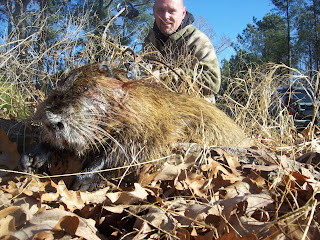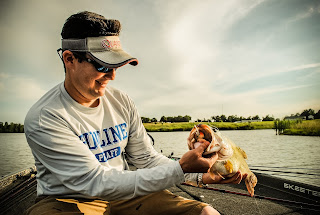I like trying normal
things a little differently. For instance, several years ago I bowhunted for
mountain lion from horseback in the high desert of Arizona. Obviously, this is
not the normal means of hunting a lion. I will routinely camp out in a tent
beside a field I intend to hunt deer to prevent alerting any that may be in the
field by driving onto the property. Earlier this year I took to the Neuse River
fishing a twenty-two mile stretch by paddleboard over one weekend. I have also
bowfished for flounder rather than using a rod and reel or a gig, and in the
process took the North Carolina state bowfishing record.
After interviewing
Brian Lockwood, otherwise known as Jetski Brian, a couple of months ago, I knew
I had to try jetski fishing off the coast. Since that time I have been working
on a ski and fishing setup so I could experience it. I wanted a setup that
would not turn the jetski into a pure fishing machine. I have three kids and I
knew if I altered the ski that much then they would not have a chance to just
have fun on it.
The challenge was
conquered by mounting rod holders and building a camera mount onto a 120 quart
cooler. Instead of using a built on cooler rack, I installed feet on the cooler
to lift it up off the back of the jetski and then rigged it so it could be
attached to the ski using the eyelets already on the ski.
 After a few fresh
water lake test runs, I knew the setup was close to what I envisioned.
After a few fresh
water lake test runs, I knew the setup was close to what I envisioned.
I made one inshore
test run off of Emerald Isle. Running about 40 miles in one day and catching a
few croakers and spots, I realized a few changes I needed to make if I was
going to take it out in the ocean. Over the next week, I was able to make the
changes and prepare for possibly my last coastal trip of this year.
I targeted an
artificial reef off of Wrightsville Beach. The fishing was reported to be good
and the weekend weather report showed expected favorable conditions.
I checked all the
extra safety precautions I added to the ski; a newly installed bilge pump, a fish
finder with gps tracking capability, two extra batteries for my cell phone and
an offline map application to use with the phone’s gps even if cell service was
not available, a vhf marine radio with one button distress signal that would
send gps coordinates in the mayday call, and second battery for the jetski
itself, just in case the main battery failed.
My wife was beyond
nervous about my trip and I printed up a map of the reef I would be fishing to
help ease her mind.
As for me, this was
going to be a challenge, but not something I feared. I have always been
comfortable with water. I learned to scuba when I was fifteen and have been
known to swim several hundred yards out in the ocean to chase dolphins. The
main challenge was going to be finding the reef. Satellite imagery works great
for hunting, as you can spot different areas fairly easy. Satellite imagery of
the ocean only shows you ocean. This trip would rely heavily on using gps
equipment by instruments only. It kind of reminds me of a pilot having to rely
on his gauges during night flights.
Second, I was going
to target some species I have never fished before.
All so I could
experience something that most will never attempt to try.
* * * * *
The morning started
early. 3:30am early in fact. The coast is a long ride from the house but the
promise was too great to not get there early. Reports on the area showed
Spanish mackerel fishing was going well in the morning and late afternoon
hours.
The track I intended
on taking would be through the Masonboro Inlet and then head to the bouy
AR-370, known as the Meares-Harriss Reef. Once putting in at the wildlife boat
ramp just over the bridge at Wrightsville Beach I was able to park quickly and
head out. The Intracoastal Waterway was nearly like glass and very few boats
were out. In fact, there were many more people paddleboarding in the area
during the early hours than there were boats heading out. Wrightsville Beach
has become somewhat of a paddleboarder’s Mecca and hosts one of the largest
paddleboard races in the world bringing in competitors from as far away as
Australia and Hawaii.
After exiting the no
wake zones I throttled on up to 30 mph. And then the unexpected happened. The
jetski chugged and shut down. I restarted it and it fired up quickly. Again, as
I throttled it up it shut down. Cursing to myself I realized a three mile plus
trip out into the ocean was not the best thing to do with a jetski acting up. I
turned to head back to the ramp.
Then I decided to
check one last thing just as I turned back on the ICW from the inlet. Sure
enough, I was able to turn the fuel switch further than the marks indicating
the tank was on. The switch was loose, so even the marks were aligned, the
switch had twisted meaning I only had the fuel on partially.
 After a few checks, I
once again gained confidence in my vessel and took toward the inlet once more.
The jetties guarding the inlet presented much rougher water but nothing that
presented concern. I stopped briefly to put a leader with a Gotcha plug
attached to a planer on the rod. I casted out just a few yards and allowed the
setup to sink and restarted the ski. As I left the inlet I drove within a
couple dozen yards of the jetty wall. The water was around 50 feet deep and 78
degrees. I tried to monitor the setup as I exited the inlet but didn’t notice
much. I continued out from the inlet a few hundred yards and stopped again to
reel in my trolling rig. Something did not feel quite right.
After a few checks, I
once again gained confidence in my vessel and took toward the inlet once more.
The jetties guarding the inlet presented much rougher water but nothing that
presented concern. I stopped briefly to put a leader with a Gotcha plug
attached to a planer on the rod. I casted out just a few yards and allowed the
setup to sink and restarted the ski. As I left the inlet I drove within a
couple dozen yards of the jetty wall. The water was around 50 feet deep and 78
degrees. I tried to monitor the setup as I exited the inlet but didn’t notice
much. I continued out from the inlet a few hundred yards and stopped again to
reel in my trolling rig. Something did not feel quite right.
That was because I hooked
my first Spanish mackerel, an eight inch specimen. Not big enough to keep, but
my first none the less.
Anxious to try my
hand at both finding the reef and experiencing the near shore fishing, I
decided to go ahead and head out to sea.
 My preparation proved
efficient and I was able to locate the reef rather easily. There were a few
other boats fishing nearby also, and I knew I was getting some strange looks. I
set up my rods for some reef fishing and dropped the baits.
My preparation proved
efficient and I was able to locate the reef rather easily. There were a few
other boats fishing nearby also, and I knew I was getting some strange looks. I
set up my rods for some reef fishing and dropped the baits.
The next several
hours consisted of bringing in fish constantly and consistently. Ten seconds on
the bottom seemed like a break as the fish attacked the bait as quickly as I
could put it in.
 In the course of the
day, I witnessed a sailboat race that painted the ocean’s surface and toward
the end waves with eight foot swells. The jetski performed flawlessly after the
fuel switch correction and acted as an enlarged bobber through the rougher
seas.
In the course of the
day, I witnessed a sailboat race that painted the ocean’s surface and toward
the end waves with eight foot swells. The jetski performed flawlessly after the
fuel switch correction and acted as an enlarged bobber through the rougher
seas.
And in the end, it
proved a viable alternative for some excellent fishing.
 I would count my shotgun shells; I used 9 shot back then,
and try to keep up with my efficiency. I still do. My father was one of the
best wing shooters I have ever seen, often taking his limit in under a box.
That was my goal, to shoot as well as him. I never out shot him. He is a
marksman for both his skill and his patience. He would pick his shots, never
taking one at a bird too far, too fast, or at the wrong angle. Seldom would he
ever take two shots, unless he was going for a double. If the first shot
missed, he figured the bird had an even greater advantage on the second.
I would count my shotgun shells; I used 9 shot back then,
and try to keep up with my efficiency. I still do. My father was one of the
best wing shooters I have ever seen, often taking his limit in under a box.
That was my goal, to shoot as well as him. I never out shot him. He is a
marksman for both his skill and his patience. He would pick his shots, never
taking one at a bird too far, too fast, or at the wrong angle. Seldom would he
ever take two shots, unless he was going for a double. If the first shot
missed, he figured the bird had an even greater advantage on the second. When a bird was not killed immediately, I learned to
dispatch the animal ethically and quickly. Many think a common oxymoron is
hunters having a heart, but contrary to this belief we care for the game.
When a bird was not killed immediately, I learned to
dispatch the animal ethically and quickly. Many think a common oxymoron is
hunters having a heart, but contrary to this belief we care for the game.





















